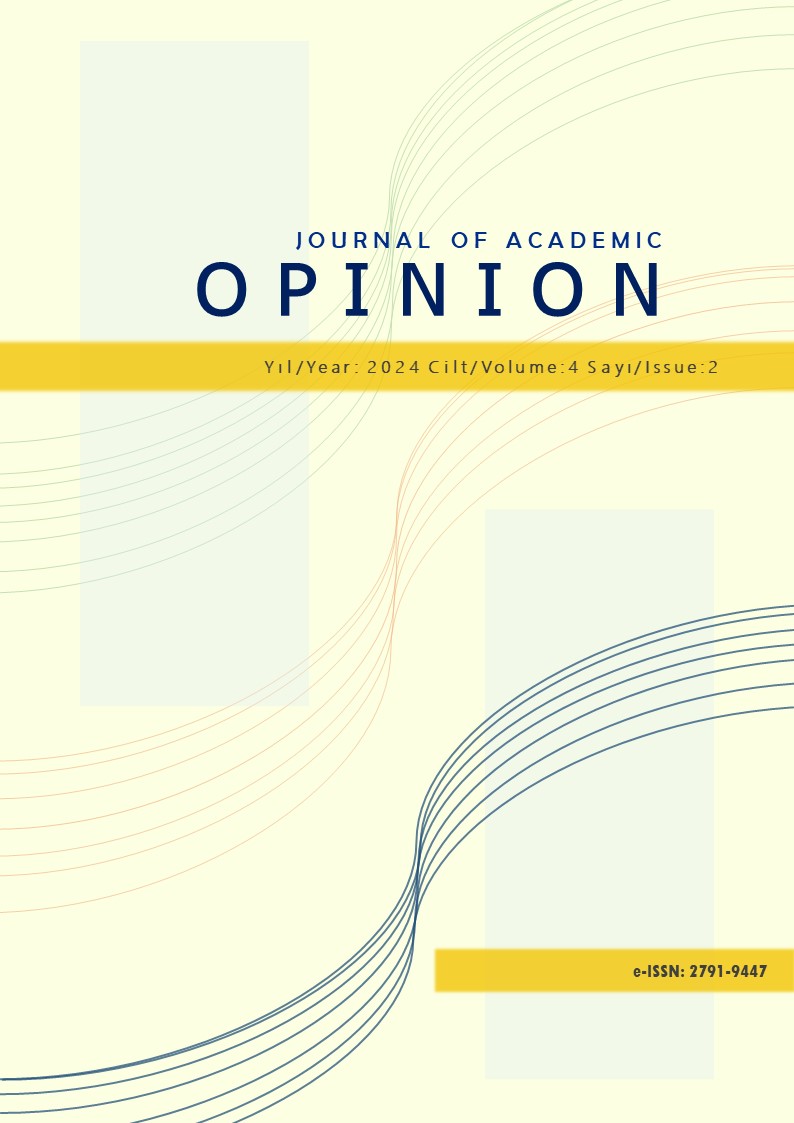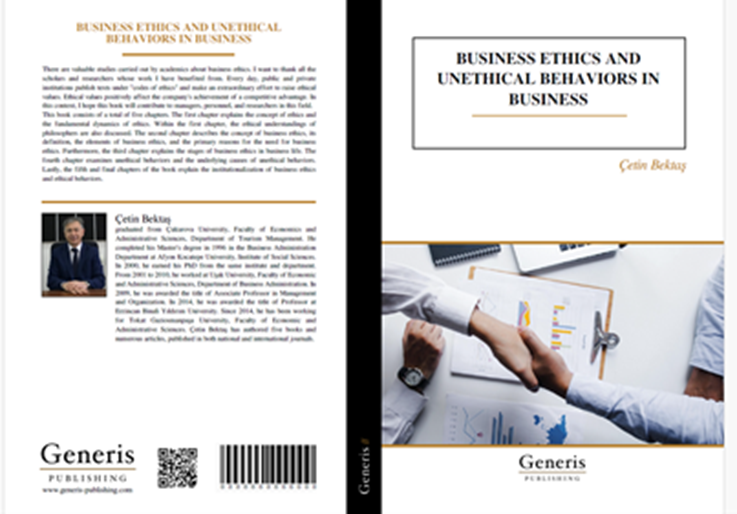The A Research on the Effects of Consumer Loans, Exchange Rate, Oil Prices on the Current Account Balance in Turkiye of Consumer Loans on Changes in the Current Account Deficit in Turkiye
Keywords:
Consumer credits, Petroleum Price, Exchange Rate, Current Account Balance, ARDL Bound TestAbstract
Current account balance/GDP (CABGDP) is an important indicator for understanding a country's position in the world economy and its external economic sustainability. Persistent current account deficits in CABGDP pave the way for many structural problems for economies. Therefore, it is important to evaluate the factors that cause current account deficit formation. This study aims to analyze the impact of consumer loans, exchange rates, and oil prices on CABGDP in Turkey. For this purpose, CABGDP, change in consumer loan volume (CREDBUYU), oil prices (LNBRENT), and exchange rate (LNREDK) are included in the analysis. Quarterly data sets for the period between 2010:Q2 and 2024:Q1 are used in the analysis. The analysis aims to examine the short- and long-run effects of changes in the volume of bank consumer loans, exchange rate, and oil price on the current account balance in Turkey. In addition, it is also aimed to investigate whether there is a long-run cointegration relationship between the variables and if there is a relationship, how long it takes for the equilibrium to occur with the “error correction coefficient.” According to the ARDL bounds test results, the variables are cointegrated in the long run. It is observed that the short-run deviations in the analyzed series disappear over time and equilibrium is reached in the long run. In the short run, it is estimated that CABGDP decreases when CREDBUYU increases. However, CABGDP increased when CREDBUYU(-1) increased. According to the findings of the analysis, the effect of the increase in the volume of consumer loans in the current period and the increase in the lagged period on the ratio of the CABGDP is different and in this case, credit expansion should be carefully managed. In the short run, it is estimated that its own lagged values have a positive effect on CABGDP, while the 2018 crisis dummy variable has a negative effect. In the long run, it is estimated that CABGDP decreases when LNBRENT increases. According to the findings of the analysis, credit policies in the short run and energy policies in the long run have significant effects on the current account balance.
References
Agnello, L. and Nerlich, C. (2012). On The Severity of Economic Downturns: Lessons From Crosscountry Evidence. Econ. Lett. 117 (1): 149–155.
Ağazade, S. (2014). Tüketici Kredilerine Yönelik Sınırlama Türkiye’nin Cari Açık Sorununa Çözüm Olur mu? Doğrusal Dışı Bir Koentegrasyon Analizi. Bankacılar Dergisi, 91: 46-54.
Akçayır, Ö. ve Albeni, M. (2016). Türkiye’de Kredi Genişlemesinin Cari Açığa Etkisi: Sınır Testi Yaklaşımı. Çankırı Karatekin Üniversitesi İktisadi ve İdari Bilimler Fakültesi Dergisi, 6(1): 557-583.
Bahmani-Oskooee, M. and Chomsisengphet, R. N. W. (2002). Long-run Demand for Money in Hong Kong: An Application of the ARDL model. International Journal of Business and Economics, 1(2): 147-155.
Baş, G. and Kara, M. (2020). The Effects of Macroeconomic Factors on Current Account Deficit: A Time Series Analysis for Turkey. International Journal of Social Science Research, 9 (1): 36-47.
BDDK (2024). Bankacılık Düzenleme ve Denetleme Kurumu, Türk Bankacılık Sektörü Temel Göstergeleri, Erişim adresi: https://www.bddk.org.tr/Veri/EkGetir/8?ekId=243, Erişim Tarihi: 14.04.2024.
Begeç E. (2015), Yurtiçi Kredi Hacmindeki Değişimlerin Makroekonomik Büyüklüklere Etkisi: Türkiye Örneği, Yüksek Lisans Tezi. Aydın: Adnan Menderes Üniversitesi, Sosyal Bilimler Enstitüsü.
Bölükbaş, M. (2019). Türkiye’de Enflasyon Cari Açık ve Bankacılık Sektörü Kredileri: 2006-2018 Dönemi İçin Bir İnceleme. Social Sciences Research Journal, 8(2): 77- 92.
Brissimis, N.Sophocles,, S. N., Hondroyiannis, G., Papazoglou, C. Tsaveas, N. T. and Vasardani, M. A. (2010). Current Account Determinants and External Sustainability in Periods of Structural Change. European Central Bank Working Paper, No: 1243
Çatalbaş, N. (2022). Türkiye’de Ekonomik Büyüme ve Cari Açık Arasındaki İlişkinin Sınanması: ARDL Sınır Testi Yaklaşımı. İnsan ve Toplum Bilimleri Araştırmaları Dergisi, 11 (2): 880-904. DOI: 10.15869/itobiad.1053296.
Dücan, E. Polat, M.A. and Balcıoğlu, E. (2016). Tüketim Toplumu Örneği Olarak Türkiye’nin Cari Açık ve Tüketici Kredileri İlişkisi. Siyaset, Ekonomi ve Yönetim Araştırmaları Dergisi, 4(1).
Eita, J. H., Manuel, V. and Naimhwaka, E. (2018). Macroeconomic Variables and Current Account Balance in Namibia. MPRA Paper, No. 88818.
Ekinci, M.F. and Omay, T. (2020). Current Account and Credit Growth: The Role of Household Credit and Financial Depth. The North American Journal of Economics and Finance, 54: 101244.
Erbaykal, E. (2007). Türkiye’de Ekonomik Büyüme ve Döviz Kuru Cari Açık Üzerinde Etkili Midir? Bir Nedensellik Analizi. Uluslararası Yönetim İktisat ve İşletme Dergisi, 3(6): 81-88.
Göçer, İ., Mercan M., and Peker, O. (2013). “Kredi Hacmi Artışının Cari Açığa Etkisi: Çoklu Yapısal Kırılmalı Eşbütünleşme Analizi”, Ekonometri ve İstatistik e-Dergisi, (18): 1-17.
Güneş, S. and Yıldırım, C. (2017). Kredi Genişlemesi ile Cari Açık Arasındaki İlişki: Türkiye Örneği. Aydın İktisat Fakültesi Dergisi, 2(1): 43-60.
Haseki, M. İ. and Avşar, İ. & Turan, T. (2023). Türkiye’de Tüketici Kredilerinin Cari Denge Üzerindeki Etkisi. Uluslararası Ekonomi ve Yenilik Dergisi, 9 (1): 19-35.
Kahiloğulları, A. and Akça, İ.E. (2021). Cari Açık ve Bütçe Açığı İlişkisi: Türkiye Örneği. Gaziantep Üniversitesi İktisat Fakültesi Dergisi. 3(2): 137-151.
Kılıç, J., and Yüksel, A. (2020). Türkiye’de Tüketici Kredilerinin Cari İşlemler Açığı Üzerindeki Etkisi: ARDL Sınır Testi Yaklaşımı. Giresun Üniversitesi İktisadi ve İdari Bilimler Dergisi, 6(1): 1-19. https://doi.org/10.46849/guiibd.626158.
Kırca, M. ve Karagöl, V. (2018). Türkiye’de Petrol Fiyatları ve Cari Açık Arasındaki Simetrik ve Asimetrik Nedensellik İlişkilerinin Analizi. Akademik Araştırmalar ve Çalışmalar Dergisi,10(18): 59-71
Kızıldere, C. (2020). Türkiye’de Cari Açık Sorununun Enerji Tüketimi ve Ekonomik Büyüme Açısından Değerlendirilmesi: Ampirik Bir Analiz. Business & Management Studies: An International Journal, 8(2): 2121-2139.
Kiyotaki, N., and Moore, J. (1997). Credit Cycles. Journal of political economy, 105(2): 211-248.
Lane, P.R. and McQuade, P. (2013). Domestic Credit Growth and International Capital Flows, European Central Bank. Working Paper Series, (1566): 1-46.
Milesi, G.A. and Razin, A. (1996). Current Account Sustaınabılıty. VII Seminario Regional de Política Fiscal. 22-25.
Motonishi, T., and Yoshikawa, H. (1999). Causes of the Long Stagnation of Japan During the 1990s: Financial or Real. Journal of the Japanese and International Economies, 13(3): 181-200.
Obstfeld, M. (2012). Does the current account still matter? NBER Working Paper No. 17877.
Pesaran, M. H., and Shin, Y. (1996). Cointegration and speed of convergence to equilibrium. Journal of econometrics, 71(1): 117-143.
Pesaran, M. H., Shin, Y. and Smith, R. J. (2001). Bounds Testing Approaches To The Analysis of Level Relationships. Journal of Applied Econometrics, 16(3): 289-326.
Sandalcılar, A. and Altıner, A. (2014). Türkiye’de Tüketici Kredileri ile Cari İşlemler Açığı Arasındaki Nedensellik İlişkisi. Bankacılar Dergisi, 89: 28-40.
Sanni, G. K., Musa, A. U. and Sani, Z. (2019). Current Account Balance and Economic Growth in Nigeria: An Empirical İnvestigation. Economic and Financial Review, 57(2): 83-106
Sezal, L. (2023). Banka Kredileri ile Cari Açık Arasındaki İlişki: Türkiye için Asimetrik Nedensellik Analizi. Selçuk Üniversitesi Sosyal Bilimler Enstitüsü Dergisi, 50: 34-44. https://doi.org/10.52642/susbed.1219328.
Sekmen, F. and Çalışır, M. (2011). Is There A Trade-Off Between Current Account Deficits And Economic Growth? The Case Of Turkey. Journal International Research Journal Of Finance And Economics, 62: 166-172.
Steiner, A. (2014). Current Account Balance and Dollar Standard: Exploring The Linkages, Journal of International Money and Finance, 41: 65-94.
TCMB EVDS (2024). Türkiye Cumhuriyet Merkez Bankası Elektronik Veri Dağıtım Sistemi. Erişim adresi: https://evds2.tcmb.gov.tr/index.php?, Erişim Tarihi: 18.04.2024.
Telatar, E. (2011). Türkiye'de Cari Açık Belirleyicileri ve Cari Açık-Kredi İlişkisi. Bankacılar Dergisi, 78: 22-34.
Uslu, H. (2019). Türkiye’de Kredi Genişlemesinin Cari Açık Üzerindeki Etkileri: ARDL Sınır Testi Yaklaşımı. Maliye ve Finans Yazıları- 2020 - (114):441 – 482.
Ünal, S. and Saygılı, R.F. (2022). Bireysel Kredilerdeki Artışın Dış Ticaret Açığı Üzerine Etkileri: Türkiye Örneği. Finans Politik & Ekonomik Yorumlar, 93-125.
OECD Data Explorer (2024). https://data-explorer.oecd.org/, (Erişim Tarihi: 25.10.2024)
Yalçıner, K. (2012). Uluslararası Finansman (1.bs.). Ankara: Detay Yayıncılık
Yanar, R. ve Kerimoğlu, G. (2011). Türkiye’de Enerji Tüketimi, Ekonomik Büyüme Ve Cari Açık İlişkisi. Ekonomi Bilimleri Dergisi, 3(2): 191-201.
Yardımcı, C. (2020). Cari İşlemler Açığı ve Kredi Hacim İlişkisi, Türkiye Örneği. Pearson Journal of Social Sciences – Humanities, (6): 235-239. doi:10.46872/pj.66.
Yurdakul, F. and Cevher, E. (2015). Determinants of Current Account Deficit in Turkey: The Conditional and Partial Granger Causality Approach. Procedia Economics and Finance, 26: 92 – 100.
Downloads
Published
How to Cite
Issue
Section
License
Copyright (c) 2024 Journal of Academic Opinion

This work is licensed under a Creative Commons Attribution 4.0 International License.





